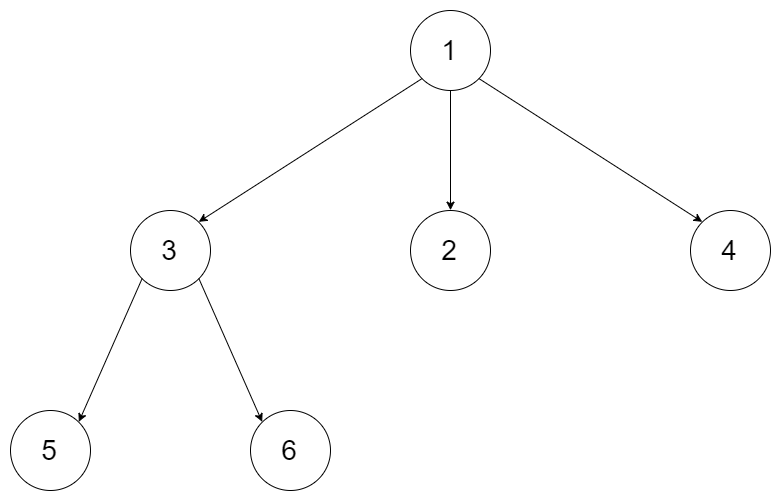树结构——层序遍历
层序遍历,是将每个结点按照深度归类进行遍历输出。
层序遍历优点:
- 能解决最短/最少结点问题,探索深度小。
- 每个结点只访问一次。
缺点:
- 内存消耗较大
思路
层序遍历的顺序是,分别遍历每个深度的结点。
示例:

结果:[[1],[3,2,4],[5,6]]
代码
前提:
1
2
3
4
5
6
7
8
9
10
11
12
13
14
15
16
17
18
19
20
21
22
23
24
25
26
27
28
|
public class Node {
public int val;
public IList<Node> children;
public Node() {}
public Node(int _val) {
val = _val;
}
public Node(int _val, IList<Node> _children) {
val = _val;
children = _children;
}
}
public IList<IList<int>> LevelOrder(Node root) {
IList<IList<int>> list = new List<IList<int>>();
if(root == null){
return list;
}
InOrder(root,list);
return list;
}
|
迭代法
迭代方案来处理一般比递归要简单一点。
使用队列前进先出的特点,可以保证是层序的遍历顺序。不过难点在于输出要每个深度一个分组的结果,那么如何得知当前结点是什么深度就很重要。
如果提供的树结构没有depth的字段,那么只能通过计数方式来获取。可以想象队列中的顺序就是层序顺序,所以只要知道第几个结点出队列时表示该深度遍历结束即可。
那么就需要两个参数来做记录。nodeCount 和 childCount 。
nodeCount记录的是本深度的结点数量,每次出队列时该参数-1。当nodeCount == 0时,表示该层的全部都出队列了,那么接下来该是下一深度的计数。而下一深度的结点数量刚好可以通过childCount来获得。childeCount记录每次子节点的遍历数量,当childCount被赋值给nodeCount时,表示当前层结点遍历完毕,childCount已经记录了下一层的所有结点数量。接着进行下一层之前赋值为0,就继续计数下下一层的节点数量。
1
2
3
4
5
6
7
8
9
10
11
12
13
14
15
16
17
18
19
20
21
22
23
24
25
26
27
28
29
30
31
32
33
34
35
36
37
38
39
40
41
42
43
44
45
46
47
48
49
50
|
private void InOrder(Node node,IList<IList<int>> list){
if(node == null){
return;
}
Queue<Node> queue = new Queue<Node>();
queue.Enqueue(node);
int nodeCount = 1;
int childCount = 0;
int depth = 1;
while(queue.Count > 0){
Node pNode = queue.Dequeue();
nodeCount --;
IList<int> cellList = null;
if(depth > list.Count){
cellList = new List<int>();
list.Add(cellList);
}else{
cellList = list[depth-1];
}
cellList.Add(pNode.val);
if(pNode.children != null && pNode.children.Count > 0){
for(int i = 0; i < pNode.children.Count;i++){
queue.Enqueue(pNode.children[i]);
}
childCount += pNode.children.Count;
}
if(nodeCount == 0){
nodeCount = childCount;
childCount = 0;
depth++;
}
}
}
|
其中的depth我用参数来记录,不过仅仅为了解决问题,其实可以直接使用list.Count 来代替depth,其主要作用就是取出当前深度的结果数组,将结果加入到当前结果数组中。
递归法(不建议)
递归方案能看出来和深度搜索中前序遍历很像。
所以这个只是结果为层序,但遍历顺序并不是。
关键仅仅是传递了depth,将结果提供给指定depth的数列中。
!!层序遍历不要使用此方法,此方法仅仅是让结果正确而已。其实质依旧是前序遍历!!
1
2
3
4
5
6
7
8
9
10
11
12
13
14
15
16
17
18
19
20
21
22
23
24
|
private void InOrder(Node node,IList<IList<int>> list,int depth){
IList<int> res = null;
if(depth > list.Count){
res = new List<int>();
list.Add(res);
}else{
res = list[depth-1];
}
res.Add(node.val);
if(node.children != null && node.children.Count > 0){
for(int i = 0; i < node.children.Count;i++){
InOrder(node.children[i],list,depth + 1);
}
}
}
|
